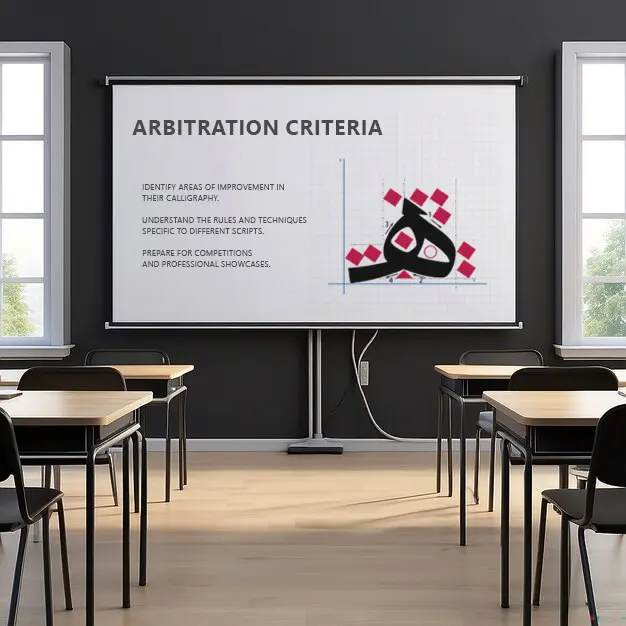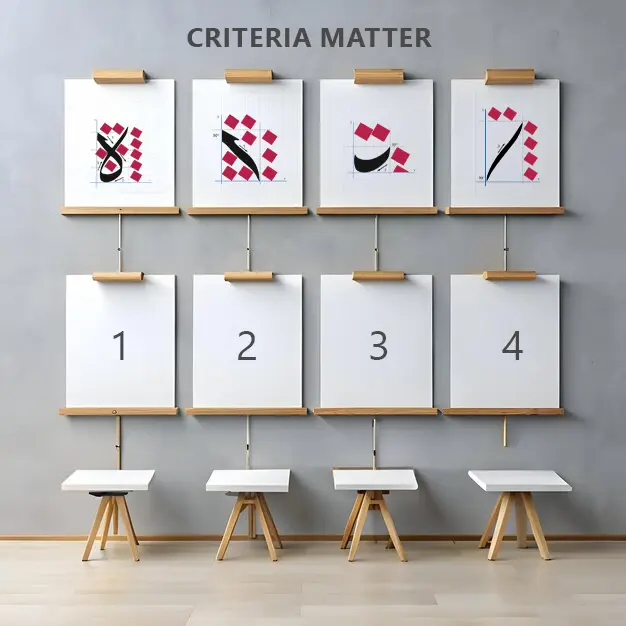Arbitration Criteria for Arabic Calligraphy Scripts
Are you ready to refine your skills and showcase your talent?
Join one of UAC’s calligraphy competitions or enroll in our workshops to learn from experts and take your art to the next level.
Overview

UAC Arbitration Process
At the University of Arabic Calligraphy (UAC), the arbitration process for Arabic calligraphy competitions and evaluations is rooted in precision, aesthetics, and authenticity. We follow meticulously defined criteria to ensure fair assessments and uphold the highest standards of this esteemed art form. These criteria serve not only as benchmarks for competitions but also as a guide for students to refine their skills and grow as calligraphers.
Arbitration Criteria
- Adherence to the traditional rules and proportions of the chosen script (e.g., Naskh, Thuluth, Ruqaa, Diwani, Kufi).
- Proper alignment and spacing between letters and words.
- Correct formation of individual letters and their ligatures according to canonical standards.
- Consistency in letter sizes and shapes.
- Observance of proportional relationships between letters and diacritical marks.
- Uniformity in pen angles and strokes for a harmonious composition.
- Balance and symmetry in the arrangement of the text.
- Creative use of space while maintaining script integrity.
- Overall visual appeal and elegance of the composition.
- Unique artistic expression within the boundaries of traditional script rules.
- Thoughtful integration of contemporary elements without compromising the authenticity of the style.
- Clean and sharp execution of strokes.
- Smooth curves and consistent line thickness.
- Absence of smudges, unnecessary marks, or inconsistencies in ink flow.
- Accurate positioning of diacritical marks (dots, tashkeel, etc.).
- Correct use and placement of vowels in the script.
- Consistency in style and size of the marks relative to the text.
- Use of appropriate materials for traditional or modern calligraphy.
- Well-prepared surfaces (e.g., treated paper for ink flow).
- Overall presentation, including borders, framing, or decoration, if applicable.
Arbitration Process
Step 1
Initial Review
Submissions are screened to ensure compliance with the rules of the competition or evaluation. Any piece failing to meet the basic requirements may not proceed to the next round.
Step 2
Detailed Assessment
Each script is examined by UAC’s expert panel of calligraphers using the criteria outlined above. Marks are awarded based on accuracy, aesthetics, and adherence to rules.
Step 3
Final Scoring
The scores from all arbitrators are consolidated, and finalists are determined. The highest-scoring scripts are re-evaluated for tie-breaking purposes, if necessary.
Step 4
Feedback and Recommendations
Participants receive constructive feedback, highlighting their strengths and areas for improvement. This step is integral to UAC’s mission of nurturing talent and fostering growth.

How UAC Supports Students
The arbitration criteria not only apply to competitions but also serve as a framework for student assessments and workshops at UAC. Students can use these standards to:
- Identify areas of improvement in their calligraphy.
- Understand the rules and techniques specific to different scripts.
- Prepare for competitions and professional showcases.

Why These Criteria Matter
The UAC arbitration criteria aim to honor the rich heritage of Arabic calligraphy while encouraging innovation and creativity. By adhering to these principles, UAC ensures a fair, transparent, and enriching experience for participants and students alike.
Downloadable Guides
Here are downloadable resources to help participants and students understand the arbitration criteria and prepare for competitions and evaluations:
- Arbitration Criteria Guide (PDF)
A detailed guide outlining the arbitration standards, scoring process, and expectations for Arabic calligraphy competitions. - Proportions and Measurements Handbook (PDF)
A reference for mastering the proportions and measurements of Arabic calligraphy scripts, including diagrams and examples. - Script Accuracy Checklist (PDF)
A comprehensive checklist for evaluating your calligraphy pieces before submission. - Presentation and Material Guidelines (PDF)
Tips on preparing your paper, ink, and tools to achieve professional-quality results. - Calligraphy Composition Tips (PDF)
A guide to creating balanced and aesthetically pleasing calligraphy compositions.
Frequently Asked Questions (FAQs)
Anyone with a passion for Arabic calligraphy, whether a beginner, intermediate, or advanced practitioner, can participate in UAC competitions. Specific competitions may have separate categories for different skill levels.
Competitions typically include popular Arabic scripts such as Naskh, Thuluth, Ruq’ah, Diwani, Kufi, and others. The specific scripts eligible will be mentioned in the competition guidelines.
Submissions are scored based on the detailed judging criteria, including script accuracy, proportions, aesthetics, creativity, and overall presentation. Each criterion carries a specific weight, ensuring a balanced evaluation.
Yes, participants will receive constructive feedback from the judging panel. This feedback is designed to help you understand your strengths and identify areas for improvement.
Participants are encouraged to use traditional calligraphy tools such as reed pens, ink, and high-quality paper. The competition guidelines may also include specifications for materials.
Digital submissions may be allowed for certain competitions. Refer to the specific competition rules for eligibility and requirements.
The timeline for judging and announcing winners will be provided in the competition details. Typically, results are announced within 2–4 weeks after the submission deadline.
In the case of a tie, the highest-scoring submissions will undergo a re-evaluation by the judging panel to determine the winner.
Yes, winners may receive prizes, certificates, and opportunities to showcase their work in UAC events or publications. Details will be outlined in the competition announcement.
Use the downloadable guides provided above, attend UAC workshops, and practice regularly while focusing on the judging criteria.




